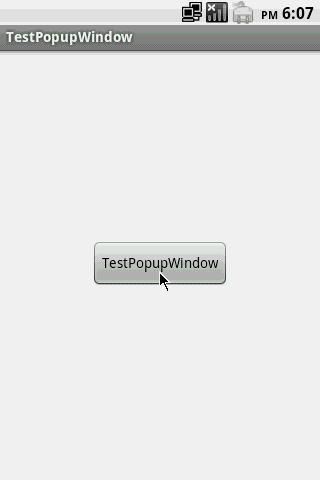PopupWindow这个功能一般都用于Android开发,我们可以根据自己的需求进行定义,这样会让我们的操作变得非常方便,爱站技术频道今天和大家分享Android自定义弹出窗口PopupWindow使用技巧,具体的介绍如下。
PopupWindow的构造函数为
public PopupWindow(View contentView, int width, int height, boolean focusable)
contentView为要显示的view,width和height为宽和高,值为像素值,也可以是MATCHT_PARENT和WRAP_CONTENT。
focusable为是否可以获得焦点,这是一个很重要的参数,也可以通过public void setFocusable(boolean focusable)来设置,如果focusable为false,在一个Activity弹出一个PopupWindow,按返回键,由于PopupWindow没有焦点,会直接退出Activity。如果focusable为true,PopupWindow弹出后,所有的触屏和物理按键都有PopupWindows处理。
如果PopupWindow中有Editor的话,focusable要为true。
下面实现一个简单的PopupWindow
主界面的layout为:
PopupWindow的layout为:
Activity的代码为:
public class MainActivity extends Activity {
private Button mButton;
private PopupWindow mPopupWindow;
@Override
protected void onCreate(Bundle savedInstanceState) {
super.onCreate(savedInstanceState);
setContentView(R.layout.activity_main);
View popupView = getLayoutInflater().inflate(R.layout.layout_popupwindow, null);
mPopupWindow = new PopupWindow(popupView, LayoutParams.MATCH_PARENT, LayoutParams.WRAP_CONTENT, true);
mPopupWindow.setTouchable(true);
mPopupWindow.setOutsideTouchable(true);
mPopupWindow.setBackgroundDrawable(new BitmapDrawable(getResources(), (Bitmap) null));
mButton = (Button) findViewById(R.id.btn_test_popupwindow);
mButton.setOnClickListener(new OnClickListener() {
@Override
public void onClick(View v) {
mPopupWindow.showAsDropDown(v);
}
});
}
}
这三行代码
mPopupWindow.setTouchable(true);
mPopupWindow.setOutsideTouchable(true);
mPopupWindow.setBackgroundDrawable(new BitmapDrawable(getResources(), (Bitmap) null));
的作用是点击空白处的时候PopupWindow会消失。
mPopupWindow.showAsDropDown(v);
这一行代码将PopupWindow以一种向下弹出的动画的形式显示出来
public void showAsDropDown(View anchor, int xoff, int yoff)
这个函数的第一个参数为一个View,我们这里是一个Button,那么PopupWindow会在这个Button下面显示,xoff,yoff为显示位置的偏移。
点击按钮,就会显示出PopupWindow

很多时候我们把PopupWindow用作自定义的菜单,需要一个从底部向上弹出的效果,这就需要为PopupWindow添加动画。
在工程res下新建anim文件夹,在anim文件夹先新建两个xml文件
menu_bottombar_in.xml
menu_bottombar_out.xml
在res/value/styles.xml添加一个sytle
Acivity修改为
public class MainActivity extends Activity {
private PopupWindow mPopupWindow;
@Override
protected void onCreate(Bundle savedInstanceState) {
super.onCreate(savedInstanceState);
setContentView(R.layout.activity_main);
View popupView = getLayoutInflater().inflate(R.layout.layout_popupwindow, null);
mPopupWindow = new PopupWindow(popupView, LayoutParams.MATCH_PARENT, LayoutParams.WRAP_CONTENT, true);
mPopupWindow.setTouchable(true);
mPopupWindow.setOutsideTouchable(true);
mPopupWindow.setBackgroundDrawable(new BitmapDrawable(getResources(), (Bitmap) null));
mPopupWindow.getContentView().setFocusableInTouchMode(true);
mPopupWindow.getContentView().setFocusable(true);
mPopupWindow.getContentView().setOnKeyListener(new OnKeyListener() {
@Override
public boolean onKey(View v, int keyCode, KeyEvent event) {
if (keyCode == KeyEvent.KEYCODE_MENU && event.getRepeatCount() == 0
&& event.getAction() == KeyEvent.ACTION_DOWN) {
if (mPopupWindow != null && mPopupWindow.isShowing()) {
mPopupWindow.dismiss();
}
return true;
}
return false;
}
});
}
@Override
public boolean onKeyDown(int keyCode, KeyEvent event) {
if (keyCode == KeyEvent.KEYCODE_MENU && event.getRepeatCount() == 0) {
if (mPopupWindow != null && !mPopupWindow.isShowing()) {
mPopupWindow.showAtLocation(findViewById(R.id.layout_main), Gravity.BOTTOM, 0, 0);
}
return true;
}
return super.onKeyDown(keyCode, event);
}
}
这样点击菜单键会弹出自定义的PopupWindow,点击空白处或者返回键、菜单键,PopupWindow会消失。
上述是Android自定义弹出窗口PopupWindow使用技巧的全部介绍,如果爱站技术频道的介绍有误的话,大家可以联系小编进行更改。





















 1488
1488











 被折叠的 条评论
为什么被折叠?
被折叠的 条评论
为什么被折叠?








